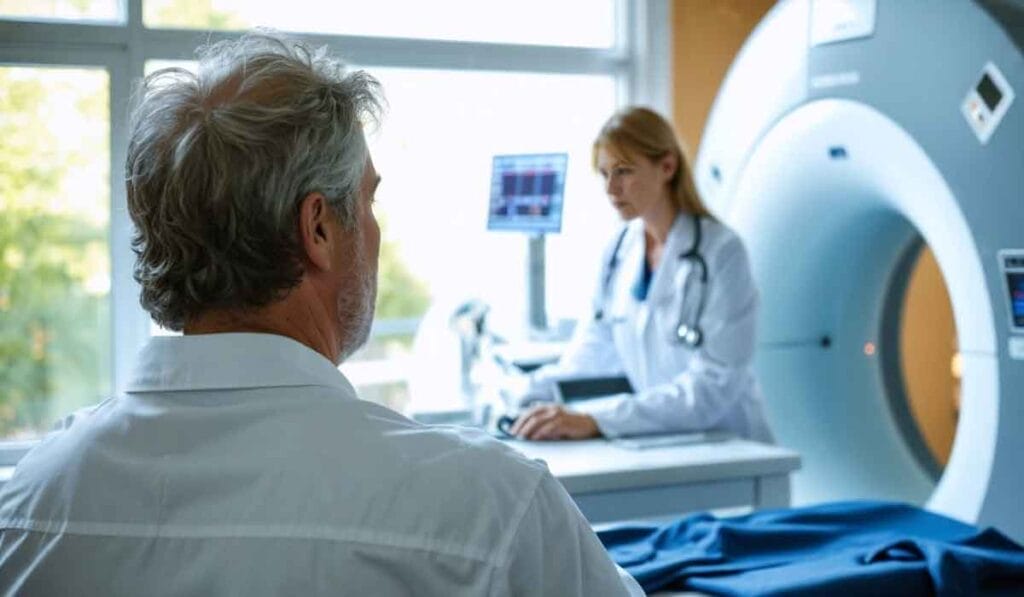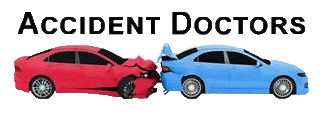Comprehensive Guide to Whiplash Symptoms
Have you ever felt sudden neck pain after a car crash?
This common issue might be whiplash.
Our article will guide you through spotting the signs of this injury and what steps to take next.
Key Takeaways
- Whiplash happens when your head moves back and forth quickly, often during car crashes.
- Signs include neck pain, stiffness, headaches at the skull base, dizziness, and fatigue.
- Seeing a doctor right away is important for treatment to avoid long-term issues.
- Treatments might include wearing a neck brace, physical therapy, or taking medicine.
- Early care helps heal whiplash faster and prevents other problems like arthritis.
Please note: We are accident doctors who charge you $0 out of pocket for the best after car accident medical care.
We can help you with whiplash from an accident too.
You should come in and get treated by us first, before you try and find an auto accident attorney in Phoenix or Mesa.
What is Whiplash?

Now that we’ve looked at the basics, let’s move on to understanding whiplash. Whiplash is a neck injury that happens when your head moves back and forth very quickly. Think of it like the cracking of a whip.
This sudden movement can hurt your neck’s soft tissues – muscles, tendons, and ligaments.
It often occurs during car accidents, especially rear-end collisions.
But it’s not just car crashes; contact sports, physical abuse, and other types of trauma can also cause this injury.
Whiplash might seem simple but dealing with it isn’t always easy. You may feel fine right after the accident only to have symptoms show up hours or days later. These can include neck pain and stiffness, headaches, dizziness, and even numbness or tingling in your arms. If you are struggling to manage your whiplash symptoms, you may want to consider seeking out a guide for managing chronic pain. This can provide you with a comprehensive understanding of your condition and offer various treatment options to help you find relief.
These symptoms include neck pain and stiffness, headaches at the base of your skull, dizziness, fatigue, and sometimes even shoulder pain or low back pain.
Because these signs can also indicate more serious conditions like nerve damage or spinal injuries, getting checked by a healthcare professional is crucial for proper diagnosis.
The key to recovery from whiplash is early intervention; understanding its signs means you’re one step closer to healing, says a physical therapist specializing in spine injuries.
Recognizing the Symptoms of Whiplash
After a car crash, knowing if you have whiplash is key. Watch for neck sorrow and feeling dizzy—it means your body’s telling you something’s not right.
Neck pain and stiffness

Neck pain and stiffness often signal a whiplash injury after a car accident.
This discomfort means your muscles or ligaments in the neck area got stretched beyond their usual range.
Imagine turning your head from side to side or nodding up and down, and you feel a sharp pain or can’t move as freely as before. That’s what neck strain feels like.
Doctors might suggest wearing a cervical collar for support during recovery. Treatments such as physical therapy, massage, and stretching exercises are also effective in relieving neck stiffness.
Pain relief options include nonsteroidal anti-inflammatory drugs (NSAIDs) like ibuprofen or naproxen to reduce swelling.
Moving on, headaches, especially at the base of the skull, are another common symptom…
Headaches, especially at the base of the skull
Headaches at the base of your skull are a common sign you might have whiplash from a car accident. These aren’t just any headaches. They often start where your head meets your neck and can spread forward like a wave.
This type of pain signals that the soft tissues and nerve roots in that area could be inflamed or damaged.
Doctors call this specific headache location cervical, relating to the spinal column at your neck’s base. If you’re feeling these headaches, it’s crucial to pay attention to them.
Over-the-counter options like acetaminophen or ibuprofen—think Motrin or Advil—can offer temporary relief but don’t ignore what your body is telling you.
Persistent pain may require more targeted treatment such as physical therapy, osteopathic manipulation, or even methods aimed at calming nerve stimulation if conventional painkillers don’t cut it.
A headache isn’t just a headache when it stems from whiplash; it’s a signal from your body that something is wrong.
Dizziness and fatigue

You might feel dizzy and tired after a car crash. These symptoms show your head and neck went through a lot.
Dizziness feels like the room is spinning, making it hard to stand or walk straight.
This happens because of vertigo, a sign that your inner ear or brain got hurt during the accident.
Fatigue means you feel more tired than usual, even if you rest a lot.
It can come from the whiplash injury itself or as part of dealing with chronic pain afterwards.
Your body uses up energy trying to heal, leaving you feeling exhausted all the time.
Pay attention to these signs—they tell you something serious could be wrong inside your body.
When to Seek Medical Attention

If you notice any signs of whiplash right after a car crash, like neck pain or headaches, it’s time to see a doctor.
Sometimes these signs might get worse or not go away.
That’s your cue to get checked out again.
A healthcare provider can run tests, possibly including X-rays or MRIs, to see what’s going on inside your body and make sure everything is okay.
They might suggest wearing a protective gear around your neck, doing some special exercises with help from physical therapy experts, or taking medicine to ease the pain and heal faster.
Don’t wait if you feel off after an accident – getting help right away could keep things from getting worse.
Immediate symptoms post-accident

Right after a car accident, you might feel fine. But then, neck pain and stiffness start setting in.
This is a tell-tale sign of whiplash injuries.
The discomfort can strike within minutes or not until several hours after the crash.
Your neck may feel tight, and turning your head could become hard.
Headaches often tag along with neck pain, especially at the base of your skull. Dizziness should not be ignored either; it’s another common symptom right after an incident.
You might shrug off these signs as minor or expect them to go away on their own.
Don’t wait too long to see if things get better by themselves – they may not without proper care from health professionals like physical therapists or doctors who understand sprains, strains, torn ligaments from sports injuries similar to whiplash-associated disorders.
Immediate attention helps prevent long-term pain and other health problems that could creep up otherwise.
Persistent or worsening symptoms

If your neck pain and stiffness refuse to go away, it’s a signal you can’t ignore. These persistent symptoms could mean your whiplash is more severe than initially thought.
You might also notice the discomfort spreading to other areas or experiencing new issues like muscle spasms or a tingling sensation, known as paresthesia.
It’s crucial to recognize these signs early on.
Seeking advice from healthcare providers becomes essential if your situation doesn’t improve.
They may recommend diagnostic tests such as CT scans or nerve blocks to get a clearer picture of the injury.
Treatment could include physical therapies, specific neck braces for immobilization, or medication like Naprosyn and muscle relaxers to manage pain and inflammation.
Don’t wait too long—early intervention can pave the way for effective rehabilitation and prevent complications like dependence on opioids or cervical spondylosis in the future.
Conclusion
Understanding the signs of whiplash after a car crash is key.
Know how seat adjustments and head restraints protect you.
If your neck hurts, feels stiff, or if headaches don’t go away, it’s time to act.
Doctors and physiotherapists can help diagnose whiplash with exams. They look for physical and neurological symptoms.
Sometimes, you might need a neck brace or treatments like traction to heal.
Don’t wait too long – getting checked early prevents more problems like arthritis or spinal damage. Keep an eye on any bruising, soreness, or that tingling sensation in your arms—it could mean something serious.
With attention and care, healing from whiplash becomes manageable. Get the right treatment; it eases symptoms faster than ignoring them.
Adjust your seat and use those head restraints every time you drive—they’re there for a reason!
Understanding these tips keeps you safer on the road.
FAQs
1. What are the typical signs of whiplash after a car accident?
The common symptoms of whiplash include soreness in the neck, bruising, and even neurological symptoms like tingling or ‘pins and needles’. Depression can also be an indirect sign due to discomfort caused by the injury.
2. How is whiplash diagnosed?
Whiplash is usually diagnosed through physical examinations by professionals such as physiotherapists. They look for physical signs in your neck vertebra and may ask about any feelings of pins and needles which could indicate damage to the spinal cord.
3. Can seat adjustments or head restraints help prevent whiplash?
Yes! Proper seat adjustment and effective use of head restraints can reduce the risk of spraining your neck during car accidents – what’s commonly known as “whiplash”.
4. Is there immediate treatment for suspected cases of whiplash following a car accident?
Indeed! Immediate attention at an emergency room is essential if you suspect you’ve suffered from a whip-lashed neck post-accident… Over-the-counter drugs like Aleve might be recommended for pain relief, while more severe cases could require wearing a neck brace or collar.
5. Are there long-term effects associated with untreated whiplash injuries?
Absolutely – untreated symptoms like persistent soreness, depression, concussion-like symptoms can lead to chronic conditions such as arthritis… It’s always advisable to seek professional guidance immediately following an accident where you suspect possible trauma to avoid these complications.

